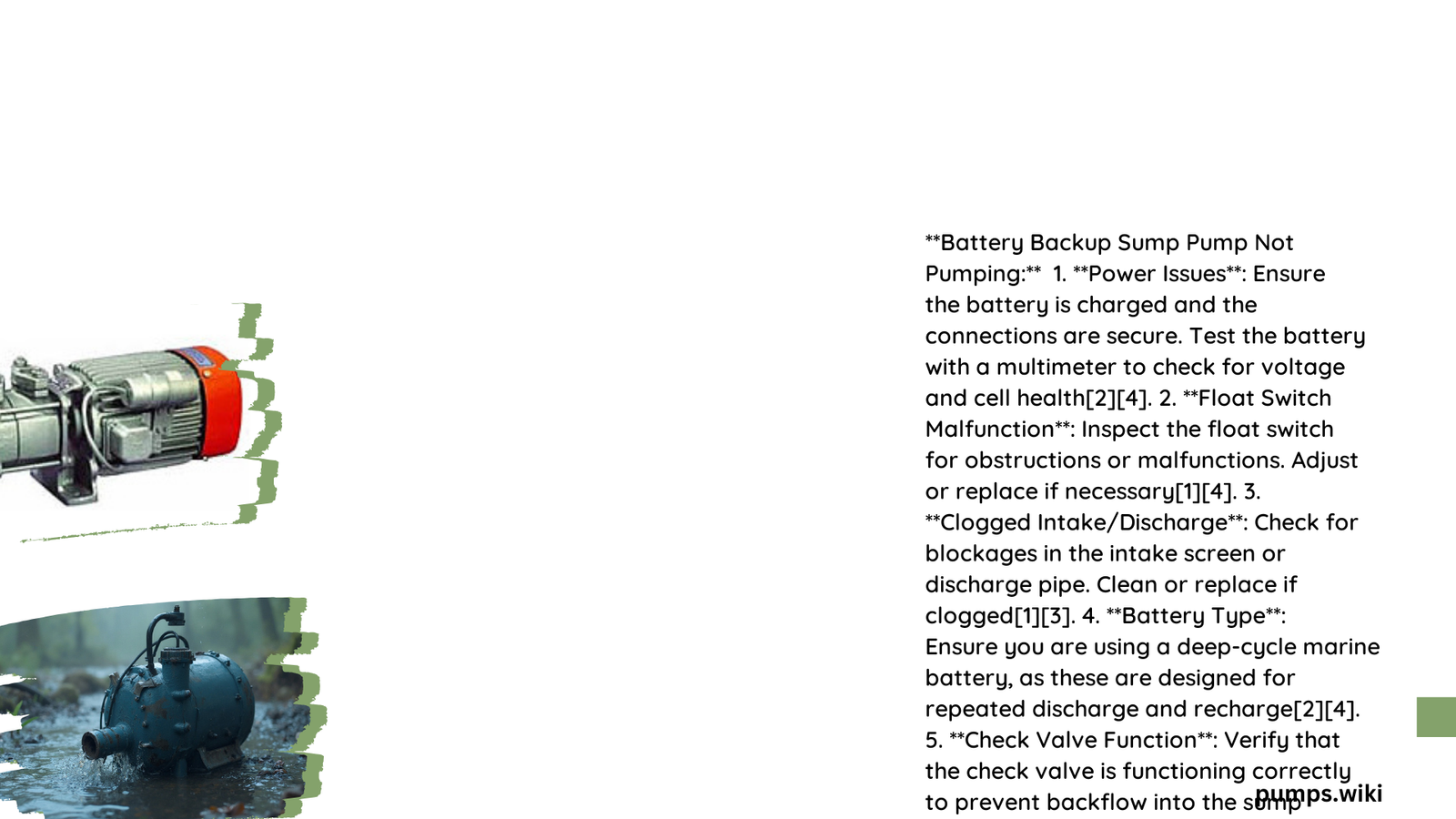A battery backup sump pump not pumping can lead to serious water damage in your basement. This issue often stems from electrical failures, float switch problems, or pump malfunctions. Understanding the common causes and troubleshooting steps can help you quickly identify and resolve the problem, potentially saving you from costly repairs and property damage.
Why Is My Battery Backup Sump Pump Not Pumping?
Battery backup sump pumps are crucial for protecting your home from water damage during power outages. When these systems fail to pump, it’s essential to diagnose and address the issue promptly. Here are the main reasons why your battery backup sump pump might not be pumping:
What Are the Common Electrical Issues?
Electrical problems are often the culprit when a battery backup sump pump fails to operate. Here are the key areas to check:
- Battery Connections:
- Look for loose wire connections or corrosion on the battery terminals.
-
Clean any corrosion with a wire brush and ensure all connections are tight.
-
Battery Health:
- Use a multimeter to check the battery voltage.
- A healthy 12-volt battery should read around 13.5 volts when the trickle charger is plugged in.
-
If the voltage drops below 12.3 volts when unplugged, it’s time for a replacement.
-
Power Source:
- Verify that the trickle charger is plugged into a working outlet.
- Check the fuse and circuit breaker associated with the pump’s power supply.
- Try resetting the circuit breaker or using a different outlet if necessary.
How Can Float Switch Problems Affect Pump Operation?
The float switch is a critical component that triggers the pump when water levels rise. Issues with the float switch can prevent the pump from activating:
- Stuck Float:
- Inspect the float to ensure it moves freely.
-
Remove any debris that might be obstructing its movement.
-
Defective Float:
-
If the float doesn’t trigger the pump when manually moved, it may need replacement.
-
Incorrect Installation:
- Verify that the float switch is installed according to the manufacturer’s specifications.
- Some systems require specific positioning to avoid false alarms or missed activations.
What Other Factors Can Cause Pump Failure?
Beyond electrical and float switch issues, other factors can contribute to pump failure:
- Circuit Board Malfunction:
- If the alarm persists after addressing other issues, the circuit board might be faulty.
-
This typically requires professional diagnosis and replacement.
-
Clogged Impeller or Inlet:
- Remove the pump and inspect the impeller and inlet for debris.
- Clean thoroughly to ensure proper water flow.
How to Maintain Your Battery Backup Sump Pump?

Regular maintenance is key to ensuring your battery backup sump pump functions reliably when needed. Here’s a maintenance checklist:
- Battery Care:
- Check battery terminals monthly for corrosion.
- Maintain proper fluid levels in wet-cell batteries.
-
Replace batteries every 4-5 years or when they fail to hold a charge.
-
Trickle Charger:
- Ensure it maintains a voltage of about 13.5 volts for a 12-volt battery.
-
Verify the charger is plugged in and functioning correctly.
-
Float Switch:
- Test the float switch manually to ensure it activates the pump.
-
Keep the area around the float clear of debris.
-
System Testing:
- Conduct a full system test at least twice a year.
- Pour water into the sump pit to verify the pump activates and removes water efficiently.
What Are the Costs Associated with Repairs and Maintenance?
Understanding the potential costs can help you budget for maintenance and repairs:
| Component | Cost Range | Replacement Time |
|---|---|---|
| Battery | $50 – $200 | 30 min – 1 hour |
| Float Switch | $10 – $50 | 15 – 30 minutes |
| Annual Maintenance | $100 – $200 (professional) | 1 – 2 hours |
DIY maintenance can significantly reduce costs, but professional servicing ensures thorough inspection and proper functioning.
How Often Should I Replace My Battery Backup Sump Pump?
While the pump itself can last 5-7 years with proper maintenance, here are key replacement guidelines:
- Battery: Every 4-5 years or when it fails to hold a charge
- Float Switch: When it fails to activate the pump (typically lasts 5+ years)
- Entire System: Consider replacement after 7-10 years, especially if repairs become frequent
Regular testing and maintenance can extend the life of your system and ensure it’s ready when you need it most.
By addressing these common issues and following a regular maintenance schedule, you can significantly reduce the risk of your battery backup sump pump not pumping when it’s needed most. Remember, when in doubt, consult with a professional plumber or pump specialist to ensure your home remains protected from water damage.
References:
1. Water Commander: My Battery Backup Sump Pump Alarm Won’t Stop Beeping (Fixes)
2. Star Water Systems: How to Fix 4 Common Sump Pump Problems
3. Farm Bureau Financial Services: What to Do If Your Sump Pump Fails (5 Causes & Fixes)
